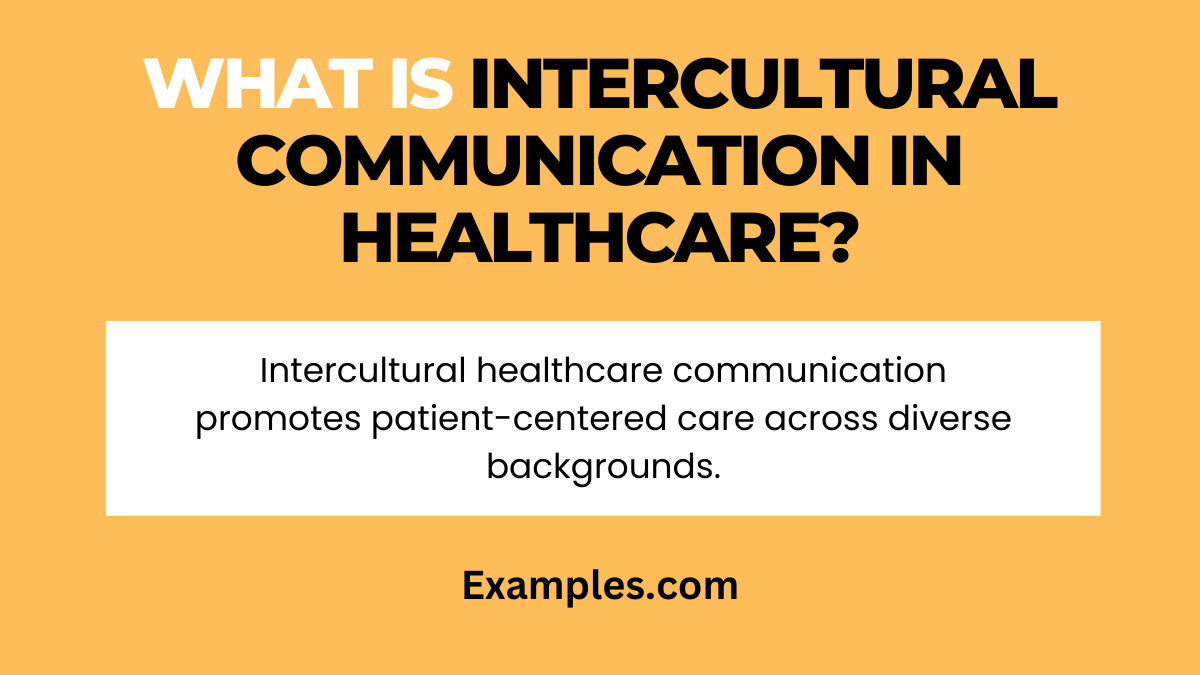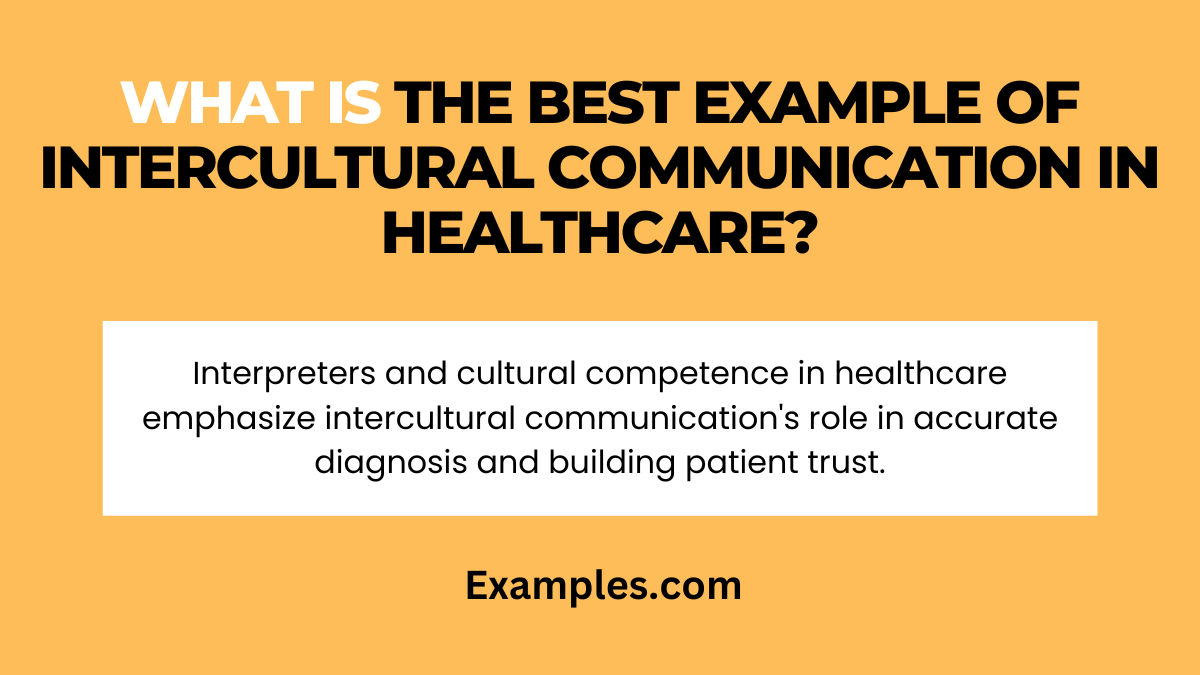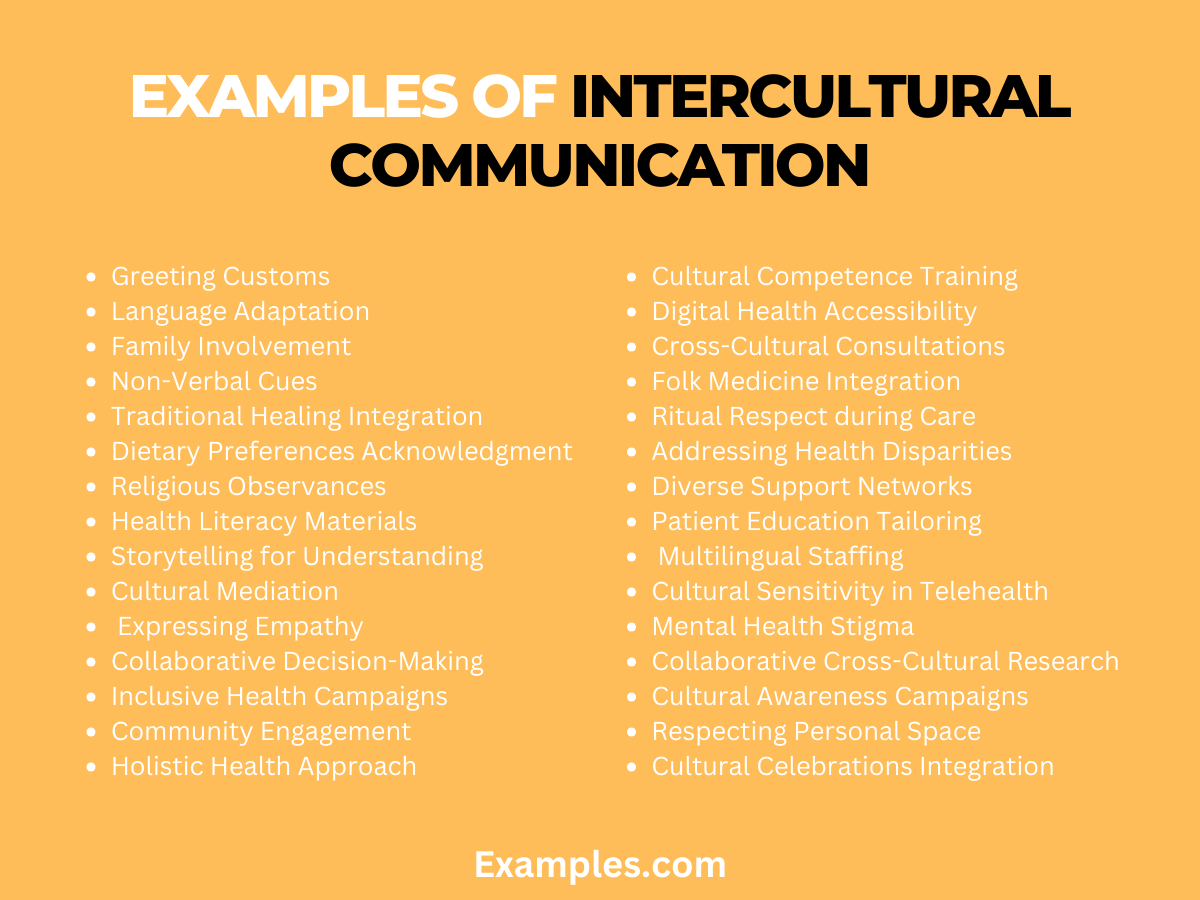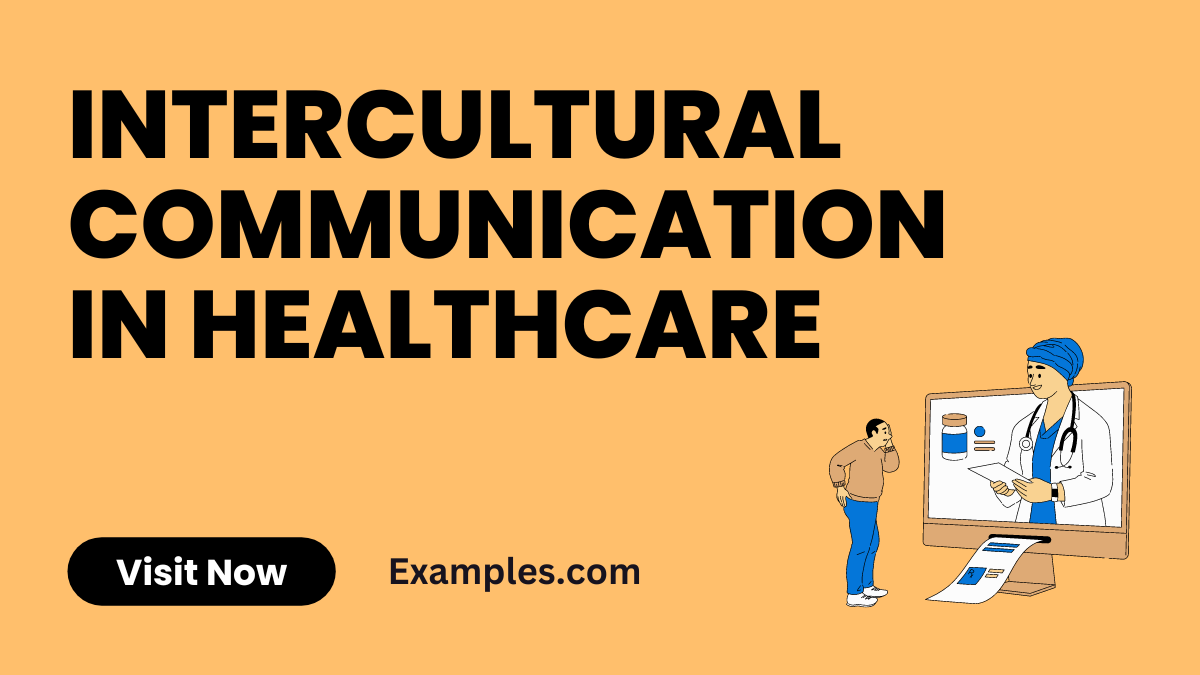29+ Intercultural Communication in Healthcare Examples
Unlock the nuances of effective intercultural communication in healthcare with our comprehensive guide. Navigating diverse cultural landscapes, this guide goes beyond theory, offering practical insights and Communication Examples to enhance understanding. Explore the strategies, methods, and purpose behind intercultural communication, empowering healthcare professionals to provide patient-centered care. From addressing cultural differences to implementing proven communication strategies, this guide is your roadmap to fostering inclusivity and achieving optimal healthcare outcomes.
What is Intercultural Communication in Healthcare?

In straightforward terms, intercultural communication in healthcare refers to the exchange of information and understanding between healthcare providers and patients from diverse cultural backgrounds. It involves navigating linguistic, societal, and behavioral differences to ensure effective and respectful communication.
Breaking it Down Intercultural communication in healthcare encompasses the ability to communicate across cultural divides, acknowledging and respecting varying customs, beliefs, and languages. It’s about fostering an environment where both healthcare professionals and patients feel heard, understood, and valued.
Why it Matters In the context of healthcare, effective intercultural communication is vital for building trust, ensuring accurate diagnosis, and providing patient-centered care. It goes beyond language proficiency, delving into the nuances of cultural sensitivity to address the unique needs of individuals from different cultural backgrounds.
Key Components This form of communication involves active listening, empathy, and an awareness of cultural nuances. It requires healthcare providers to adapt their communication styles, considering factors such as non-verbal cues, familial involvement, and traditional health practices.
The Goal Ultimately, the goal of intercultural communication in healthcare is to bridge gaps, reduce disparities, and promote positive health outcomes for all patients, regardless of their cultural background. It’s about fostering an inclusive and respectful healthcare environment that recognizes and celebrates diversity.
What is the best Example of Intercultural Communication in Healthcare?

Illustrating the Power of Understanding: A Case of Exemplary Intercultural Communication
In a notable healthcare instance, a multicultural medical team seamlessly collaborated to address a patient’s complex needs. The patient, hailing from a diverse cultural background, faced challenges in expressing symptoms due to language barriers. The medical team, armed with cultural competence, employed effective communication strategies, including interpreters and visual aids. By embracing the patient’s cultural context, the team not only ensured accurate diagnosis but also fostered a trusting patient-provider relationship. This real-world example highlights the transformative impact of intercultural communication in delivering superior healthcare.
30 Examples of Intercultural Communication

1. Greeting Customs: Navigating diverse greetings, from handshakes to bows, exemplifies intercultural communication’s richness.
2. Language Adaptation: Witness effective communication through language adaptability, where professionals switch effortlessly between languages.
3. Family Involvement: Understanding family dynamics in healthcare decisions showcases intercultural sensitivity in patient care.
4. Non-Verbal Cues: Decoding non-verbal cues like eye contact or gestures highlights nuanced intercultural communication skills.
5. Traditional Healing Integration: Integrating traditional healing practices into modern healthcare exemplifies cultural respect and inclusion.
6. Dietary Preferences Acknowledgment: Respecting diverse dietary choices showcases sensitivity to cultural nuances and individual preferences.
7. Religious Observances: Aligning healthcare schedules with religious observances illustrates consideration for diverse faiths.
8. Health Literacy Materials: Crafting health materials in multiple languages ensures accessibility, promoting health literacy for all.
9. Storytelling for Understanding: Sharing patient stories across cultures fosters empathy and a deeper understanding of diverse experiences.
10. Cultural Mediation: Utilizing cultural mediators to bridge communication gaps demonstrates a commitment to clear understanding.
11. Expressing Empathy: Expressing empathy across cultural boundaries establishes a strong foundation for effective healthcare.
12. Collaborative Decision-Making: Involving patients in collaborative decision-making respects diverse perspectives in healthcare choices.
13. Inclusive Health Campaigns: Creating health campaigns that resonate with various cultures promotes inclusivity and awareness.
14. Community Engagement: Engaging with diverse communities in healthcare initiatives fosters trust and cooperation.
15. Holistic Health Approach: Adopting a holistic approach that integrates cultural beliefs into treatment plans enhances patient outcomes.
16. Cultural Competence Training: Training healthcare professionals in cultural competence ensures a more inclusive and understanding practice.
17. Digital Health Accessibility: Ensuring digital health tools are accessible across languages and cultures promotes healthcare equity.
18. Cross-Cultural Consultations: Facilitating consultations where multiple healthcare perspectives contribute ensures comprehensive care.
19. Folk Medicine Integration: Integrating folk medicine into treatment options acknowledges diverse healthcare practices.
20. Ritual Respect during Care: Respecting cultural rituals during healthcare procedures demonstrates sensitivity to individual beliefs.
21. Addressing Health Disparities: Tailoring interventions to address specific health disparities among diverse populations is crucial.
22. Diverse Support Networks: Recognizing and involving diverse support networks showcases an understanding of varied patient needs.
23. Patient Education Tailoring: Customizing patient education materials to different cultures ensures clear understanding and compliance.
24. Multilingual Staffing: Having multilingual staff ensures effective communication, reducing language barriers in healthcare.
25. Cultural Sensitivity in Telehealth: Applying cultural sensitivity in telehealth settings maintains effective communication remotely.
26. Mental Health Stigma: Addressing mental health stigma within cultural contexts promotes open discussions and support.
27. Collaborative Cross-Cultural Research: Collaborating on research with diverse teams contributes to a more holistic understanding of healthcare.
28. Cultural Awareness Campaigns: Conducting campaigns that raise awareness about cultural health practices fosters understanding.
29. Respecting Personal Space: Acknowledging and respecting diverse concepts of personal space enhances patient comfort.
30. Cultural Celebrations Integration: Integrating cultural celebrations into healthcare settings promotes a festive and inclusive environment.
Cultural Differences in Intercultural communication?
- Acknowledging Cultural Differences:
- In intercultural communication, recognizing and embracing cultural differences is fundamental for effective interactions.
- Diverse Cultural Norms and Customs:
- Unravel the intricacies of diverse cultural norms, exploring how they shape communication styles and interactions in intercultural settings.
- Rich Tapestry of Cultural Diversity:
- Explore the rich tapestry of cultural diversity influencing intercultural communication.
- Understand variations in communication styles, non-verbal cues, and societal expectations.
- Impact of Language on Communication:
- Delve into the profound impact of language on intercultural communication.
- Identify strategies to bridge linguistic gaps, ensuring clear and effective communication in healthcare.
- Strategies for Bridging Linguistic Gaps:
- Uncover practical strategies for bridging linguistic gaps in intercultural healthcare communication.
- Emphasize the importance of clear and concise communication for optimal healthcare outcomes.
- Cultural Influences on Healthcare Practices:
- Discover how cultural customs and traditions influence various aspects of healthcare practices.
- Gain a nuanced understanding of their impact on patient-doctor relationships and treatment preferences.
- Identification and Challenge of Stereotypes:
- Addressing stereotypes is crucial for fostering effective intercultural communication.
- Learn to identify and challenge stereotypes in healthcare, promoting inclusivity and a patient-centered approach.
- Promoting Inclusive and Patient-Centered Approaches:
- Discuss the importance of promoting inclusive and patient-centered approaches in healthcare communication.
- Emphasize how overcoming stereotypes contributes to a more welcoming and culturally sensitive healthcare environment.
Importance of intercultural communication in healthcare?
- Significance of Intercultural Communication in Healthcare:
- In the dynamic healthcare landscape, intercultural communication plays a crucial role in fostering understanding and empathy.
- Building Trust Through Communication:
- Explore how intercultural communication contributes to building trust between healthcare providers and patients from diverse backgrounds.
- Learn strategies to navigate cultural nuances, creating a supportive and trusting healthcare environment.
- Link Between Communication and Health Disparities:
- Uncover the link between effective intercultural communication and the reduction of health disparities.
- Gain insights into tailoring healthcare approaches to diverse populations, addressing disparities in access and outcomes.
- Direct Impact on Healthcare Outcomes:
- Discover the direct impact of intercultural communication on healthcare outcomes.
- Understand how cultural sensitivity and effective communication strategies contribute to positive patient experiences and improved health results.
- Ethical and Legal Considerations:
- Navigate the legal and ethical dimensions of intercultural communication in healthcare.
- Gain clarity on respecting cultural differences while adhering to professional standards, ensuring ethical and legal practices in diverse healthcare settings.
- Equipping Healthcare Professionals:
- Understand the role of intercultural communication in equipping healthcare professionals with the knowledge and skills needed for culturally competent and patient-centered care.
- Emphasize the importance of adapting practices in an increasingly diverse healthcare environment.
Role of Culture in Health Communication?
- Cultural Impact on Health Communication:
- Culture significantly shapes health communication, influencing beliefs, practices, and communication styles.
- Perceptions Molded by Culture:
- Explore how cultural nuances mold perceptions in health communication, affecting how individuals interpret and respond to healthcare information.
- Language and Non-Verbal Cues:
- Understand the intricacies of language and non-verbal cues in cultural contexts, recognizing their role in facilitating or impeding effective communication.
- Cultural Competence Defined:
- Define cultural competence and its pivotal role in healthcare communication.
- Emphasize how understanding diverse cultures enhances healthcare professionals’ ability to provide equitable and patient-centered care.
- Fostering Cultural Understanding:
- Highlight the importance of fostering cultural understanding for effective healthcare communication.
- Explore how cultural competence contributes to improved patient-provider relationships.
- Strategies for Reducing Health Disparities:
- Investigate the link between culture and health disparities, recognizing the impact of cultural awareness on reducing inequalities.
- Explore strategies that leverage cultural competence to bridge gaps and promote health equity.
- Active Listening in Cross-Cultural Communication:
- Stress the importance of active listening in cross-cultural communication, emphasizing its role in understanding diverse perspectives.
- Explore how active listening fosters trust and improves communication outcomes.
- Empathy in Multicultural Healthcare:
- Discuss the role of empathy in multicultural healthcare settings, acknowledging its significance in building rapport with patients from diverse backgrounds.
- Explore how empathy contributes to patient satisfaction and positive health outcomes.
Intercultural communication in healthcare settings?
- Role of Intercultural Communication in Healthcare Outcomes:
- Intercultural communication is a linchpin for successful healthcare outcomes, weaving through the complex tapestry of healthcare settings.
- Foundation of Trust in Intercultural Communication:
- Explore how trust forms the foundation of effective intercultural communication in healthcare.
- Uncover strategies for building and maintaining trust between healthcare providers and patients from diverse cultural backgrounds.
- Significance of Cultural Sensitivity:
- Dive into the significance of cultural sensitivity in patient care within healthcare settings.
- Understand how cultural sensitivity contributes to positive patient experiences by respecting diverse healthcare beliefs and individual preferences.
- Addressing Language Barriers:
- Highlight the paramount importance of addressing language barriers in intercultural healthcare communication.
- Explore strategies such as language adaptation, interpreter utilization, and the importance of clear, concise communication in diverse linguistic settings.
- Fostering Inclusivity in Healthcare:
- Delve into the role of intercultural communication in fostering an inclusive healthcare environment.
- Learn how embracing diversity enhances teamwork, reduces biases, and ensures equitable access to healthcare services.
- Navigating Challenges in Intercultural Communication:
- Anticipate and overcome challenges in intercultural communication within healthcare settings.
- Gain insights into addressing stereotypes, navigating different communication styles, and effectively managing the complexities of diverse cultural interactions.
- Empowering Healthcare Professionals:
- This guide empowers healthcare professionals with the knowledge and skills needed to navigate the complexities of cultural diversity for improved patient care and outcomes.
- Emphasize the practical and actionable insights provided in the guide for healthcare professionals to enhance their intercultural communication competencies.



